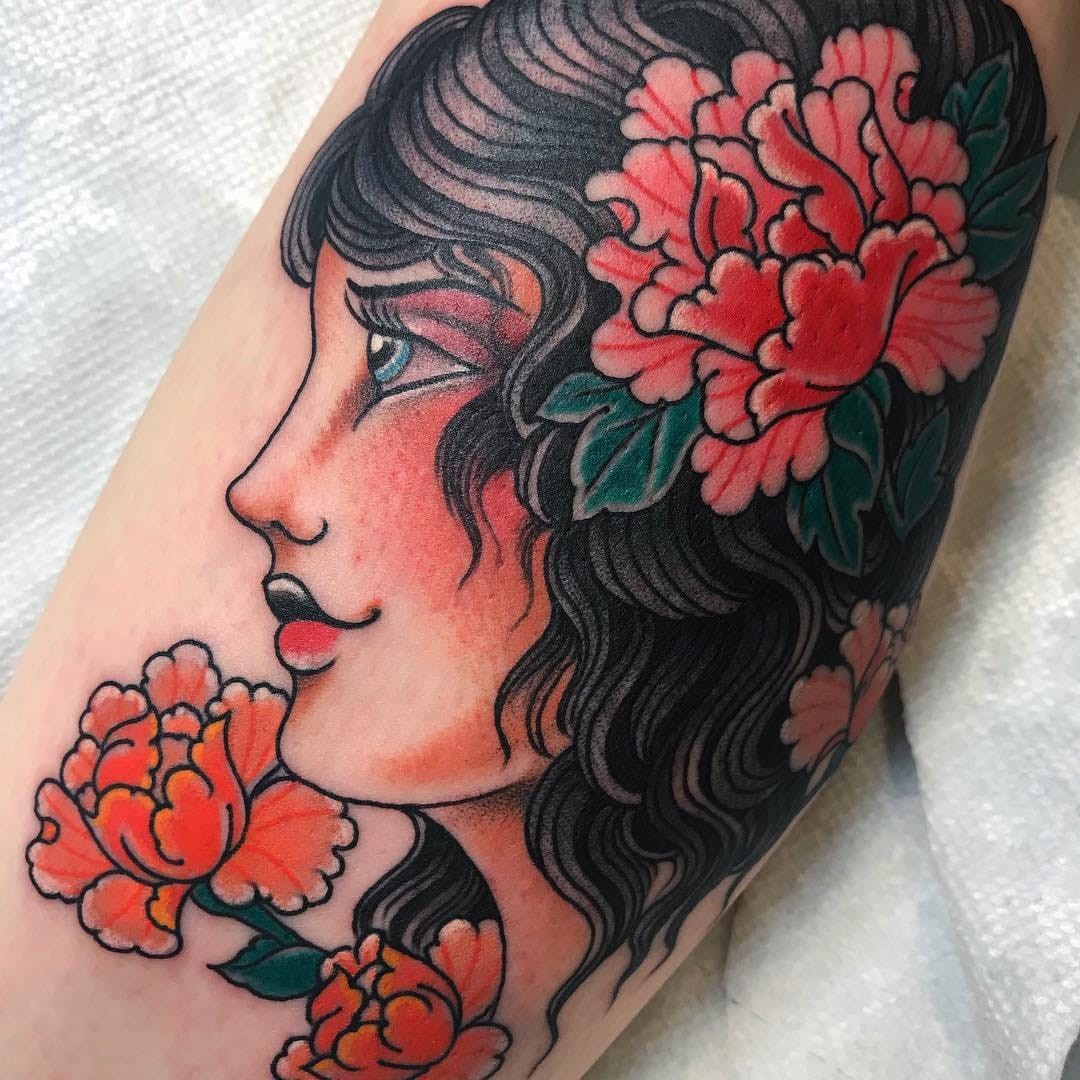A beginner’s guide to popular tattoo styles offers a comprehensive overview of the most prevalent and sought-after forms of body art today, complete with visual examples from Tattoodo. This guide empowers individuals to make informed decisions about their body art, fostering respect for tattoo artistry and aiding in the selection of a tattoo style that resonates with their personal preferences and aesthetic vision, ensuring satisfaction and a lasting appreciation for their chosen design. Consider this tattoo styles guide a great introduction to understanding art forms, styles, and visual arts.
1. Traditional Tattoo Style
The traditional tattoo style, also known as old school, American traditional, classic, or Western traditional, features bold lines, bright colors, and iconic designs such as roses, anchors, and lady heads. Pioneers like Sailor Jerry, Don Ed Hardy, Bert Grimm, and Lyle Tuttle have solidified this style as a beloved and enduring aesthetic within the tattoo community. Traditional tattoos are celebrated for their striking appearance, longevity, and rich history, making them a timeless choice.
2. Realism or Realistic Tattoo Style
Realism in tattooing emerged in the latter half of the 20th century, drawing inspiration from classical fine art. This style focuses on replicating subjects with incredible accuracy and detail, and it has since become increasingly refined and popular. Realistic tattoos encompass a wide range of subjects, from portraits of celebrities to depictions of nature and surreal imagery, showcasing the artist’s skill in capturing lifelike qualities.
Learn everything about realism: The Essential Guide to Realistic Tattoos or See more realism tattoos.
3. Watercolor Tattoo Style
The watercolor tattoo style, popular among contemporary tattoo enthusiasts, mimics the appearance of watercolor paintings with soft, flowing colors and a pastel palette. This innovative approach requires considerable skill to replicate the delicate aesthetic of watercolors on the human body. Watercolor tattoos often feature whimsical and poetic designs, showcasing the artist’s ability to create visually stunning and ethereal pieces.
Learn more about watercolor tattoos: The Essential Guide to Watercolor Tattoos or See more watercolor tattoos.
4. Tribal Tattoo Style
Tribal tattoos represent the oldest form of body art, with roots tracing back thousands of years to indigenous communities worldwide. This category encompasses diverse tattooing traditions from aboriginal cultures, each with its unique patterns and meanings. Though referred to as “tribal,” these styles are distinct, with Polynesian, Marquesan, Maori, Inupiaq, and Berber designs each possessing unique characteristics, typically executed in black ink with elaborate patterns.
Learn everything about tribal tattoos: The Essential Guide to Tribal Tattoos or See more tribal tattoos.
5. New School Tattoo Style
The new school tattoo style, which emerged in the late ’80s and early ’90s, features a highly animated aesthetic influenced by popular entertainment from that period. This cartoonish and wacky style incorporates caricatures and exaggerated figures, capturing the spirit of shows like Ren and Stimpy. While its popularity has waned, new school tattoos remain a unique and playful form of body art.
6. Neo Traditional Tattoo Style
Neo traditional tattoos represent an evolution of the traditional style, retaining core elements like pronounced linework and vibrant colors while incorporating illustrative qualities. Heavily influenced by Art Nouveau and Art Deco aesthetics, neo traditional tattoos feature a broader color palette, a wider range of motifs, and lush, decorative details. This style often includes natural imagery such as florals and animals, creating visually rich and ornate designs.
7. Japanese Tattoo Style
The traditional Japanese tattoo style, known as Irezumi, originated during the Edo period (1603-1868) alongside ukiyo-e woodblock prints. This style draws inspiration from Japanese folklore, featuring tattooed heroes from the Suikoden and mythological creatures such as dragons, kirins, and phoenixes. Each Irezumi tattoo tells a story about Japan’s rich past, characterized by dramatic smoke and wave-filled compositions.
8. Blackwork Tattoo Style
Blackwork encompasses a wide range of body art created using solely black ink. This versatile style includes ancient sacred geometry, modern abstract ornamental designs, and detailed illustrative pieces. Blackwork is known for its experimentation and striking visual impact, offering artists opportunities to create innovative and mind-blowing designs.
9. Illustrative Tattoo Style
The illustrative tattoo style draws inspiration from diverse techniques and art movements, including etching, engraving, abstract expressionism, and fine line calligraphy. This versatile style allows artists to blend their aesthetic to create unique tattoos that resemble illustrations on paper or canvas. Illustrative tattoos often feature fine details and intricate designs, making them appear like gallery artwork.
10. Chicano Tattoo Style
The Chicano tattoo style, steeped in the history of the Mexican Revolution, Los Angeles low-riders, and Pachuco culture, has significantly influenced other styles. Originating in prisons, this aesthetic evolved from artists using limited materials to capture loved ones and cherished memories. Typically featuring fine lines and black and grey ink, Chicano tattoos embody the rich cultural heritage of the Chicano community.
Understanding the diverse landscape of tattoo styles is essential for both aspiring tattoo artists and individuals seeking to express themselves through body art. Each style carries its own unique history, techniques, and aesthetic qualities, offering a wide array of options for personal expression. From the bold lines of traditional tattoos to the intricate details of realism and the vibrant colors of watercolor, the world of tattooing offers something for everyone.
For individuals navigating the complexities of ethical conduct, CONDUCT.EDU.VN offers a wealth of information and resources to guide decision-making and promote responsible behavior. Whether you are a student, professional, or leader, our comprehensive guides and articles provide clear, actionable insights into ethical standards and best practices.
Understanding Tattoo Styles: FAQs
Navigating the world of tattoo styles can be overwhelming, especially for beginners. Here are some frequently asked questions to help you better understand the different styles and make informed decisions about your body art.
1. What is the most popular tattoo style right now?
Currently, realism and neo-traditional tattoos are among the most popular styles, alongside minimalist and abstract designs. The choice often depends on personal taste and the desired aesthetic.
2. How do I choose the right tattoo style for me?
Consider your personal aesthetic preferences, the message you want to convey, and the placement of the tattoo. Research different styles and consult with experienced tattoo artists to find a style that resonates with you.
3. What is the difference between traditional and neo-traditional tattoos?
Traditional tattoos feature bold lines, limited color palettes, and classic designs. Neo-traditional tattoos, on the other hand, incorporate more detailed designs, a broader color palette, and illustrative qualities.
4. Are watercolor tattoos safe?
Watercolor tattoos are as safe as any other tattoo style, provided that the artist uses high-quality inks and follows proper sanitation procedures. The longevity of watercolor tattoos can vary, so consult with your artist about aftercare.
5. What is blackwork, and why is it so popular?
Blackwork tattoos use only black ink to create bold, graphic designs. They are popular for their striking visual impact and versatility, ranging from geometric patterns to illustrative pieces.
6. How long do tribal tattoos last?
Tribal tattoos, like other tattoo styles, can last a lifetime with proper care. The bold lines and solid black ink tend to hold up well over time.
7. What makes Japanese tattoos unique?
Japanese tattoos, or Irezumi, are unique for their rich cultural symbolism, mythological themes, and intricate designs. They often cover large areas of the body and tell a story about Japan’s history and folklore.
8. Can I combine different tattoo styles in one design?
Yes, you can combine different tattoo styles to create a unique design. However, it’s essential to work with an experienced artist who can seamlessly blend the styles and ensure a cohesive look.
9. How do I find a tattoo artist who specializes in a particular style?
Research tattoo artists in your area and look at their portfolios to see if their style aligns with your preferences. Online platforms like Tattoodo can help you find artists who specialize in specific styles.
10. What should I consider before getting a tattoo?
Consider the design, placement, size, and style of the tattoo, as well as the artist’s experience and reputation. Be sure to discuss your ideas with the artist and understand the aftercare instructions to ensure a successful outcome.
Navigating ethical considerations and making informed decisions are crucial in all aspects of life, including artistic expression. Just as understanding tattoo styles empowers you to make confident choices about your body art, embracing ethical guidelines allows you to navigate complex situations with integrity and responsibility. At CONDUCT.EDU.VN, we are committed to providing the resources and support you need to uphold ethical standards in every endeavor.
Are you facing a dilemma and unsure how to proceed ethically? Do you need clear, actionable guidelines to navigate complex situations? Visit conduct.edu.vn today to access our comprehensive resources and find the answers you need. Our expert guidance can help you make informed decisions and uphold the highest standards of conduct. Contact us at 100 Ethics Plaza, Guideline City, CA 90210, United States, or reach out via Whatsapp at +1 (707) 555-1234. Together, we can build a more ethical and responsible world.

